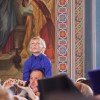The relationship between religion and art is not a contradictory relationship, nor an identical one. There exists between them a kinship and a peculiar mutual aid. Both religion and art raise us up and awaken in us a striving towards an ideal world. But if the esthetic feeling strives mainly towards an artistic image of the ideal world, then the religious feeling thirsts for living communion with God, the source of all perfection. The esthetic feeling, being under the influence of the contemplation of an artistic work or the beauty of nature, creates only a vague impulse in our soul to a higher world, but religious feeling opens to our soul the possibility of living communion with God through prayer and the sacraments. Substituting the religious feeling with the esthetic feeling is a great and harmful distortion, named in asceticism as “delusion”.

Common between religion and art is that they both strive to express an idea not in an abstract form (such as in, for example, philosophy and science), but in a concrete visual expression.
In religion, as in art, a pure idea is dressed in its corresponding cover of an image, both a pure cover, as well as a beautiful one. Thanks to this quality, all the spiritual-bodily feelings of the person participate in the spiritual contemplation of the idea. The dogmatic and moral understanding of the church is not only dressed in the images of verbal fine art and beautiful musical clothes, but is symbolized in the majesty of the ritual form of services.
Not one of the ancient religions was strange to symbols, but the most perfect Christian religion shows itself an exception by its depth, and inexhaustible in its variety and richness of symbolic images. The “mysteries of the future age” are expressed in a dumb tongue, silence, both visible and invisible.
Philosophical history teaches us that religion was the first cradle of art. The perspective by which religion and art are recognized as being principally hostile to each other should be recognized as mistaken. This hostility begins only when the essence of religion is distorted (as for example, in Manicheanism, which considered the mother of evil as an independent being), or when the form of art does not correspond to the religious idea.
A hostile attitude to all images and forms of art in their relationship to
church worship led in its own time to iconoclasm.
The Christian church does not reject art. Christianity is a religion of an
incarnate God, Christ, in whom appeared “the whole fullness of the godhead bodily” (Col. 2, 9). Having sanctified the flesh and having condemned only sin in the flesh, Christianity blessed the various forms of art for Christian worship, having condemned only sin in art. The sin of art begins where it forgets about its divine origin and begins to serve evil.















